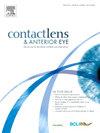Analyzing corneal biomechanical response in orthokeratology with differing back optic zone diameter: A comparative finite element study
IF 3.7
3区 医学
Q1 OPHTHALMOLOGY
引用次数: 0
Abstract
Purpose
To investigate the impact of orthokeratology (ortho-k) lenses with different back optic zone diameter (BOZD) on the biomechanical response of the cornea, focusing on contact pressure, displacement, and stress distribution.
Method
Finite element models were developed to simulate varying corneal curvatures (39.0D, 42.0D, 45.0D) and ortho-k lenses designed to target myopia reductions of −2.0D, −4.0D, and −6.0D, with BOZD values of 5.0 mm and 6.0 mm. Key parameters—contact pressure, displacement, mechanical treatment zone (MTZ) diameter and von Mises stress—were calculated and compared across the models.
Result
The BOZD = 5 mm group demonstrated higher central contact pressure and greater central corneal displacement compared to the BOZD = 6 mm group. Additionally, the BOZD = 5 mm group exhibited a smaller central contact range, corneal reshaping range, and MTZ diameter than the BOZD = 6 mm group. The maximum stress decreased and shifted locations from the center to the periphery after lens application in both groups, with a more significant decrease observed in the 6 mm group.
Conclusion
BOZD plays a crucial role in corneal biomechanical responses during ortho-k treatment. Smaller BOZD lenses result in a more concentrated contact area, leading to a smaller corneal reshaping area and MTZ diameter without significantly increasing the maximum stress in the cornea.
不同后视区直径角膜塑形术中角膜生物力学响应分析:比较有限元研究。
目的:研究不同光学后区直径(BOZD)的角膜矫形(ortho-k)镜片对角膜生物力学反应的影响,重点是接触压力、位移和应力分布:建立有限元模型,模拟不同的角膜曲率(39.0D、42.0D、45.0D)和矫形角膜塑形镜,设计目标是将近视度数降低-2.0D、-4.0D 和 -6.0D,BOZD 值分别为 5.0 毫米和 6.0 毫米。计算并比较了各种型号的关键参数--接触压力、位移、机械处理区(MTZ)直径和 von Mises 应力:结果:与BOZD=6毫米组相比,BOZD=5毫米组的中心接触压力更高,角膜中心位移更大。此外,BOZD = 5 毫米组的中央接触范围、角膜重塑范围和 MTZ 直径均小于 BOZD = 6 毫米组。戴镜后,两组的最大应力都有所下降,并从中心向周边移动,6 毫米组的下降幅度更大:结论:在角膜矫形治疗过程中,BOZD对角膜生物力学反应起着至关重要的作用。BOZD越小,接触面积越集中,从而导致角膜重塑面积和MTZ直径越小,但角膜上的最大应力不会显著增加。
本文章由计算机程序翻译,如有差异,请以英文原文为准。
求助全文
约1分钟内获得全文
求助全文
来源期刊

Contact Lens & Anterior Eye
OPHTHALMOLOGY-
CiteScore
7.60
自引率
18.80%
发文量
198
审稿时长
55 days
期刊介绍:
Contact Lens & Anterior Eye is a research-based journal covering all aspects of contact lens theory and practice, including original articles on invention and innovations, as well as the regular features of: Case Reports; Literary Reviews; Editorials; Instrumentation and Techniques and Dates of Professional Meetings.
 求助内容:
求助内容: 应助结果提醒方式:
应助结果提醒方式:


